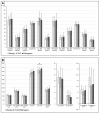Electrocardiogram Features of Left Ventricular Excessive Trabeculation with Preserved Cardiac Function in Light of Cardiac Magnetic Resonance and Genetics
- PMID: 39407966
- PMCID: PMC11477278
- DOI: 10.3390/jcm13195906
Electrocardiogram Features of Left Ventricular Excessive Trabeculation with Preserved Cardiac Function in Light of Cardiac Magnetic Resonance and Genetics
Abstract
Background and Objectives: Although left ventricular excessive trabeculation (LVET) can cause heart failure, arrhythmia and thromboembolism, limited literature is available on the ECG characteristics of primary LVET with preserved left ventricular function (EF). We aimed to compare the ECG characteristics and cardiac MR (CMR) parameters of LVET individuals with preserved left ventricular EF to a control (C) group, to identify sex-specific differences, and to compare the genetic subgroups of LVET with each other and with a C population. Methods: In our study, we selected 69 LVET individuals (EF > 50%) without any comorbidities and compared them to 69 sex- and age-matched control subjects (42% females in both groups, p = 1.000; mean age LVET-vs-C: 38 ± 14 vs. 38 ± 14 years p = 0.814). We analyzed the pattern and notable parameters of the 12-lead ECG recordings. We determined the volumetric and functional parameters, as well as the muscle mass values of the left and right ventricles (LV, RV) based on the CMR recordings. Based on the genotype, three subgroups were established: pathogenic, variant of uncertain significance and benign. Results: In the LVET group, we found normal but elevated volumetric and muscle mass values and a decreased LV_EF, wider QRS, prolonged QTc, higher RV Sokolow index values and lower T wave amplitude compared to the C. When comparing MR and ECG parameters between genetic subgroups, only the QTc showed a significant difference. Over one-third of the LVET population had arrhythmic episodes and a positive family history. Conclusions: The subclinical morphological and ECG changes and the clinical background of the LVET group indicate the need for follow-up of this population, even with preserved EF.
Keywords: ECG; cardiac magnetic resonance imaging; cardiogenetics; left ventricular excessive trabeculation; noncomapction.
Conflict of interest statement
The authors declare no conflicts of interest. The funders had no role in the design of the study; in the collection, analyses, or interpretation of data; in the writing of the manuscript; or in the decision to publish the results.
Figures



Similar articles
-
Inherited Hypertrabeculation? Genetic and Clinical Insights in Blood Relatives of Genetically Affected Left Ventricular Excessive Trabeculation Patients.Life (Basel). 2025 Jan 22;15(2):150. doi: 10.3390/life15020150. Life (Basel). 2025. PMID: 40003559 Free PMC article.
-
Impact of Right Ventricular Trabeculation on Right Ventricular Function in Patients With Left Ventricular Non-compaction Phenotype.Front Cardiovasc Med. 2022 Apr 12;9:843952. doi: 10.3389/fcvm.2022.843952. eCollection 2022. Front Cardiovasc Med. 2022. PMID: 35498016 Free PMC article.
-
Characteristics of the right ventricle in left ventricular noncompaction with reduced ejection fraction in the light of dilated cardiomyopathy.PLoS One. 2023 Sep 25;18(9):e0290981. doi: 10.1371/journal.pone.0290981. eCollection 2023. PLoS One. 2023. PMID: 37747903 Free PMC article.
-
The significance of left ventricular ejection time in heart failure with reduced ejection fraction.Eur J Heart Fail. 2021 Apr;23(4):541-551. doi: 10.1002/ejhf.2125. Epub 2021 Mar 23. Eur J Heart Fail. 2021. PMID: 33590579 Review.
-
[Doubts of the cardiologist regarding an electrocardiogram presenting QRS V1-V2 complexes with positive terminal wave and ST segment elevation. Consensus Conference promoted by the Italian Cardiology Society].G Ital Cardiol (Rome). 2010 Nov;11(11 Suppl 2):3S-22S. G Ital Cardiol (Rome). 2010. PMID: 21361048 Italian.
References
-
- Petersen S.E., Jensen B., Aung N., Friedrich M.G., McMahon C.J., Mohiddin S.A., Pignatelli R.H., Ricci F., Anderson R.H., Bluemke D.A. Excessive Trabeculation of the Left Ventricle: JACC: Cardiovascular Imaging Expert Panel Paper. JACC Cardiovasc. Imaging. 2023;16:408–425. doi: 10.1016/j.jcmg.2022.12.026. - DOI - PMC - PubMed
Grants and funding
LinkOut - more resources
Full Text Sources

